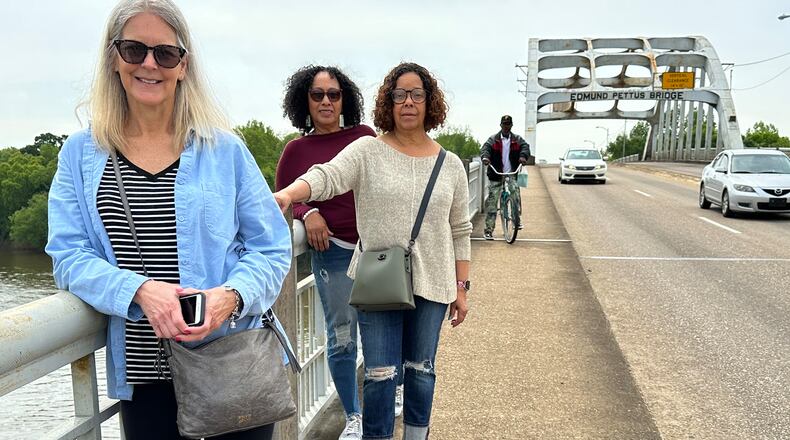She took along two retired teacher friends – Donna King, who taught in Dayton, and her sister, Vicki Wharton, who taught in Nashville. The sisters, whose hometown was Mt. Sterling, KY, grew up during segregation there.
Donna’s late husband, Bruce (a Birmingham native) had grown up with Clifton Casey and both participated in the Children’s Crusade, as had Clifton’s late cousin, Harold Higgins — all three were arrested and spent time in jail. Harold’s widow, Doris, and Clifton met the teachers at the Civil Rights Museum to share their stories and tour the museum.
Bruce had told Donna that “adults grew tired of protesting and getting beaten and arrested, so Dr. King suggested that recruiters go into the schools and recruit children — my husband was one of those, like classmate Clifton and Doris’ husband. They walked in Kelly Ingram Park, across from the 16th St. Baptist Church, were assaulted by dogs and water hoses, arrested, and went to jail. So many participated that the jail ran out of room.”
Clifton, his cousin Harold, and Bruce spent days in jail, “and I never wanted to go back again,” Clifton said. After graduation, Bruce went to college at Morehead State University where he met Donna, and Clifton joined the Army and went to Vietnam. “I became one of the test cases for Agent Orange and now suffer health issues from that, as well as Agent Green and other toxic agents used.”
He went to college and got a degree in accounting, then went to Germany to do taxes for military employees and soldiers.
When he retired, he returned to Birmingham; the Civil Rights Museum had been built across from Kelly Ingram Park, cater-corner from the 16th St Baptist Church, where four girls had been killed in a church bombing. He became a volunteer tour guide at the museum.
Although Doris didn’t participate in the Children’s Crusade, she had her own “foot soldier” experience, and said she didn’t feel comfortable visiting the museum because it “brought back too many memories of what we lived through.
“I was one of the young people who went into neighborhoods to register folks to vote and let them know there was no voting tax, as they had been told to discourage blacks from voting.
“A bus or van would drop us off in various neighborhoods, then pick us up later. On one trip back, a car pulled alongside our van and men started shooting at the top of the van; I think they just meant to scare us off, because if they had shot lower, we would have been killed.”
Doris had also known Donna’s husband, and she and Clifton shared stories about him with Donna.
“I really enjoyed hearing those stories of Bruce from high school, and can share them with our children and grandchildren,” said Donna.
After Birmingham, the teachers set out for Tuskegee; Donna and Vicki’s father had been a tail gunner for the Tuskegee Airmen. Then, they went on to Montgomery, Selma and back to Montgomery to go through the Legacy Museum and Memorial.
“The memorial, which documents lynchings by state, was very emotional,” said Donna.
“I refused to go to the memorial,” said Vicki, “because our grandmother used to tell the story of a lynching in Mount Sterling, which has haunted me. But I enjoyed the museum.”
“People might think they know about the people and events we read about but they know so little,” said Federspiel. “Seeing these sites, meeting people who participated, put it all in a new perspective. It was so informative, but disturbing — I can’t even imagine how African Americans deal with that history. At the Legacy Memorial, it was awful to see the vast number of people lynched, some just by numbers but no names — so dehumanizing. In Arkansas, 300 Black veterans returned from WWI and were granted land, but the whites wanted the land for themselves, so they lynched all 300 of those veterans.
“This wasn’t a vacation — it was exhausting at times, not so much physically as mentally. I saw and learned things I can take back to my classroom — I just wish I could take the kids there.”
Contact this writer at virgburroughs@gmail.com
About the Author




